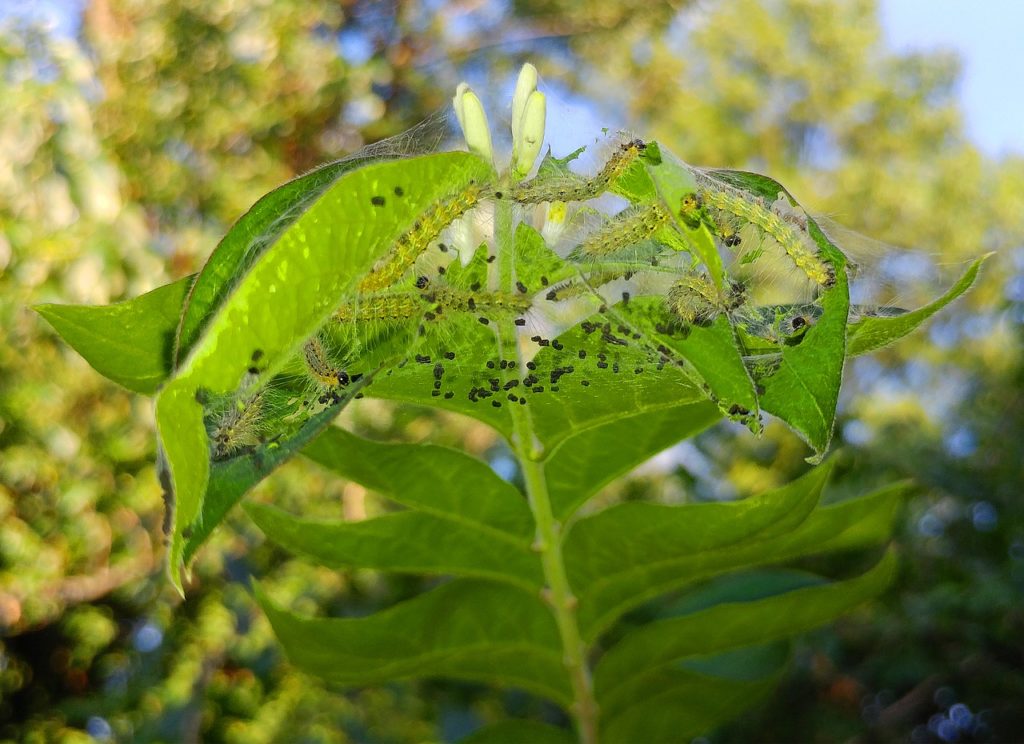Introduction
In fall, while preparing for winter dormancy, many plants shed their leaves in a burst of color. During this period, certain tree insects can be easily identified. The following examines some of the most frequently observed fall tree insects, and how they impact their hosts.
Fall Webworm (Hyphantria cunea)
Fall webworm is a native insect of North America. During its larval stage, fall webworm consumes the leaves of various trees and shrubs. While considered a relatively innocuous pest, dense populations can cause minor to significant defoliation on host plants. Most infested plants will recover from defoliation within a single growing season.
Hosts
Fall webworm feeds on over 636 species of plants, including alder, ash, cherry, cottonwood, elm, maple, persimmon, sweetgum, walnut, willow, and birch. In the eastern United States, the insect’s preferred hosts are pecan, walnut, American elm, hickory, crabapple, and maple. In the western United States, fall webworm commonly infests alder, willow, cottonwood, and various fruit trees.
Symptoms of Infestation
The larvae envelop branches in large webs, and devour the foliage. In forested settings, this generally results in minor defoliation. The webs that the larvae construct are not injurious to plants, but can reduce the aesthetic quality of the tree. Severe infestations may cause trees that are already weakened to decline further.
Treatment
· Most plants generally recover from substantial defoliation, especially if it occurs late in the growing season.
· Fall webworm has several natural predators that help limit its populations. Birds, insect predators, and parasitoids prey on the eggs and larvae.
· Webbed branches may be pruned and destroyed. Pruning is not advised if it would interfere with the aesthetic shape of the plant.
· Larvae can be controlled using a registered insecticide. Applications should be performed in July, when larvae are small. Larvae become more resistant to insecticides as they mature.
· Avoid burning any webs or larvae. Fire can damage, or kill the host plant.
Oak Leaf Gall Mite (Pyemotes herfsi)
Oak leaf gall mite (Pyemotes herfsi), also known as itch mite, is a secondary invader of oak trees that parasitizes numerous insects. It is notable for its reproductive capabilities. Each female can carry up to 250 offspring at a time. When mature, the females enter galls that have formed on oak trees, and parasitize the larvae residing within.
Once the females have given birth, the mites drop from the gall, and are dispersed by air currents to surrounding locations. During this period, the mites often inadvertantly make contact with humans, and attempt to feed on them. If a human has been bitten by an oak leaf gall mite, the affected skin will develop a red patch, with a small bump arising in the center. While the irritation caused by the mites is typically minor, a few hospitalizations have been reported.
Hosts
Oak leaf gall mite infests red oaks. It is most partial to pin oak. The insect tends to feed on oak midge larvae, but it also parasitizes Anobium punctatum, the Asiatic honey bee, Grapholita molesta, periodic cicadas, the pink bollworm, Tineola bisselliella, and various pests of stored grains. Oak leaf gall mite will also attempt to feed on humans and animals.
Symptoms of Infestation
The galls associated with oak leaf gall mite are tiny, extending up to 1/8 of an inch in width. The galls are induced by a gall midge, a type of fly that infests a bevy of trees. Oaks are especially susceptible. The galls are initially green. At first, they are inconspicuous, blending in with the plant’s foliage. They become more visible in fall, once they have hardened, and turned brown. Oak trees that exhibit foliar discoloration, with leaves that are distorted or crusty, may be infested. Galls that are plucked from infested trees and opened will reveal the mature females.
Management
· The incidence of biting can be reduced by concealing vulnerable parts of the body when around infested trees.
· Insect repellents can be applied to clothing to reduce or eliminate the potential for bites, although the efficacy of insect repellents varies.
· After spending time outdoors in an infested area, place any clothing you have worn in a washing machine, and cleanse them with laundry detergent and hot water. This will eliminate any mites that have attached themselves to the fabric. Oak leaf gall mites can reside on clothing for several days if not tended to.
· Immerse yourself in hot water, and wash your body thoroughly with a washcloth and soap. The soap will immediately kill any mites that are present on your body. Shampoo and rinse your hair to prevent the mites from biting your scalp.
· Ensure that windows and doors are sealed shut to deter the mites from traveling indoors.
· Pesticides are not recommended for use in controlling oak leaf gall mite. The mites dwell within the oak galls, which protect them from spray applications.
· Soothe bites with organic anti-itch creams. Refrain from scratching bites, as this can result in further inflammation.


